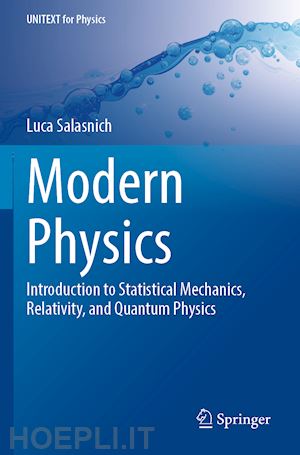Table of Contents
1 Classical Statistical Mechanics
1.1 Kinetic Theory of Gases
1.1.1 Maxwell Distribution of Velocities
1.1.2 Maxwell-Boltzmann Distribution of Energies
1.1.3 Single-Particle Density of States
1.2 Statistical Ensembles of Gibbs
1.2.1 Microcanonical Ensemble
1.2.2 Canonical Ensemble
1.2.3 Grand Canonical Ensemble
1.2.4 Many-Particle Density of States
2 Special Relativity
2.1 Lorentz Transformations
2.2 Einstein Postulates
2.2.1 Gedanken Experiment of Einstein
2.3 Relativistic Mechanics
2.3.1 Relativistic Kinematics
2.3.2 Relativistic Dynamics
3 Quantum Properties of Light
3.1 Black-Body Radiation
3.1.1 Ideal Black Body
3.1.2 Derivation of the Planck Law
3.2 Photoelectric E ect
3.2.1 Experimental Data
3.2.2 Theoretical Explanation
3.3 Energy and Linear Momentum of a Photon
3.4 Compton E ect
3.4.1 Theoretical Explanation
4 Quantum Energy Levels of Atoms
4.1 Energy Spectra
4.1.1 Energy Spectrum of Hydrogen Atom
4.2 Hydrogen Atom of Bohr
4.2.1 Derivation of the Bohr Results
4.3 Energy Levels and Photons
4.4 Electromagnetic Transitions
5 Wave Properties of Matter
5.1 De Broglie Wavelength
5.1.1 Explaining the Bohr Quantization
5.2 Experiment of Davisson and Germer
5.3 Double-Slit Experiment with Light
5.4 Double-Slit Experiment with Electrons
5.5 Old Quantum Mechanics of Bohr, Wilson and Sommerfeld
5.6 Matrix Quantum Mechanics of Heisenberg, Born and Jordan
5.7 Wave Quantum Mechanics of Schrodinger
5.7.1 Derivation of the Schr odinger Equation
5.8 Formal Quantization Rules
5.8.1 Schr odinger Equation for a Free Particle
5.8.2 Schr odinger Equation for a Particle in an External Potential
5.9 Stationary Schr odinger Equation
6 Axioms of Quantum Mechanics
6.1 Matrix Mechanics
6.2 Axioms of Quantum Mechanics
7 Applications of Quantum Mechanics
7.1 Quantum Particle in a One-Dimensional Box Potential
7.2 Quantum Particle in a One-Dimensional Harmonic Potential
8 Quantum Physics of Atoms
8.1 Quantum Particle in a Separable Potential
8.1.1 Quantum Particle in the Harmonic Potential
8.2 Dirac Notation for a Quantum State
8.3 Electron in the Hydrogen Atom
8.3.1 Schr odinger Equation in Spherical Polar Coordinates
8.3.2 Selection Rules
8.4 Pauli Exclusion Principle and the Spin
8.5 Semi-Integer and Integer Spin: Fermions and Bosons
8.6 The Dirac Equation
8.6.1 The Pauli Equation and the Spin
8.6.2 Dirac Equation with a Central Potential
8.6.3 Relativistic Hydrogen Atom and Fine Splitting
8.6.4 Relativistic Corrections to the Schr odinger Hamiltonian
9 Quantum Mechanics of Many-Body Systems
9.1 Identical Quantum Particles
9.1.1 Spin-Statistics Theorem
9.2 Non-Interacting Identical Particles
9.2.1 Atomic Shell Structure and the Periodic Table of the Elements
9.3 Interacting Identical Particles
9.3.1 Variational Principle
9.3.2 Electrons in Atoms and Molecules
10 Quantum Statistical Mechanics
10.1 Quantum Statistical Ensembles
10.1.1 Quantum Microcanonical Ensemble
10.1.2 Quantum Canonical Ensemble
10.1.3 Quantum Grand Canonical Ensemble
10.2 Bosons and Fermions at Finite Temperature
10.2.1 Gas of Photons at Thermal Equlibrium
10.2.2 Gas of Massive Bosons at Thermal Equlibrium
10.2.3 Gas of Non-Interacting Fermions at Zero Temperature
Appendix A Dirac Delta Function
A.1 The Heaviside Step Function
A.2 The Strange Function of Dirac
A.2.1 Dirac Function and the Integrals
A.3 Dirac Function in D Spatial Dimensions
Appendix B Complex Numbers
B.1 Set of Complex Numbers
B.2 Gauss Plane
B.2.1 Polar Representation
B.3 Euler Formula
B.3.1 Proof of the Euler Formula
B.3.2 De Moivre Formula
B.4 Fundamental Theorem of Algebra
B.5 Complex Functions
Appendix C Fourier Transform
C.1 Geometric and Taylor Series
C.2 Fourier Series .
C.2.1 Complex Representation of the Fourier Series
C.3 Fourier Integral
C.3.1 Properties of the Fourier Transform
C.3.2 Fourier Transform and Uncertanty Theorem
C.4 Fourier Transform of Space-Time Functions
Appendix D Di erential equations
D.1 First-Order Ordinary Di erential Equations
D.1.1 Separation of Variables
D.2 Second-Order Ordinary Di erential Equations
D.3 Newton Law as a Second-Order ODE
D.4 Partial Di erential Equations
D.4.1 Wave Equation
D.4.2 Di usion Equation
Bibliography











